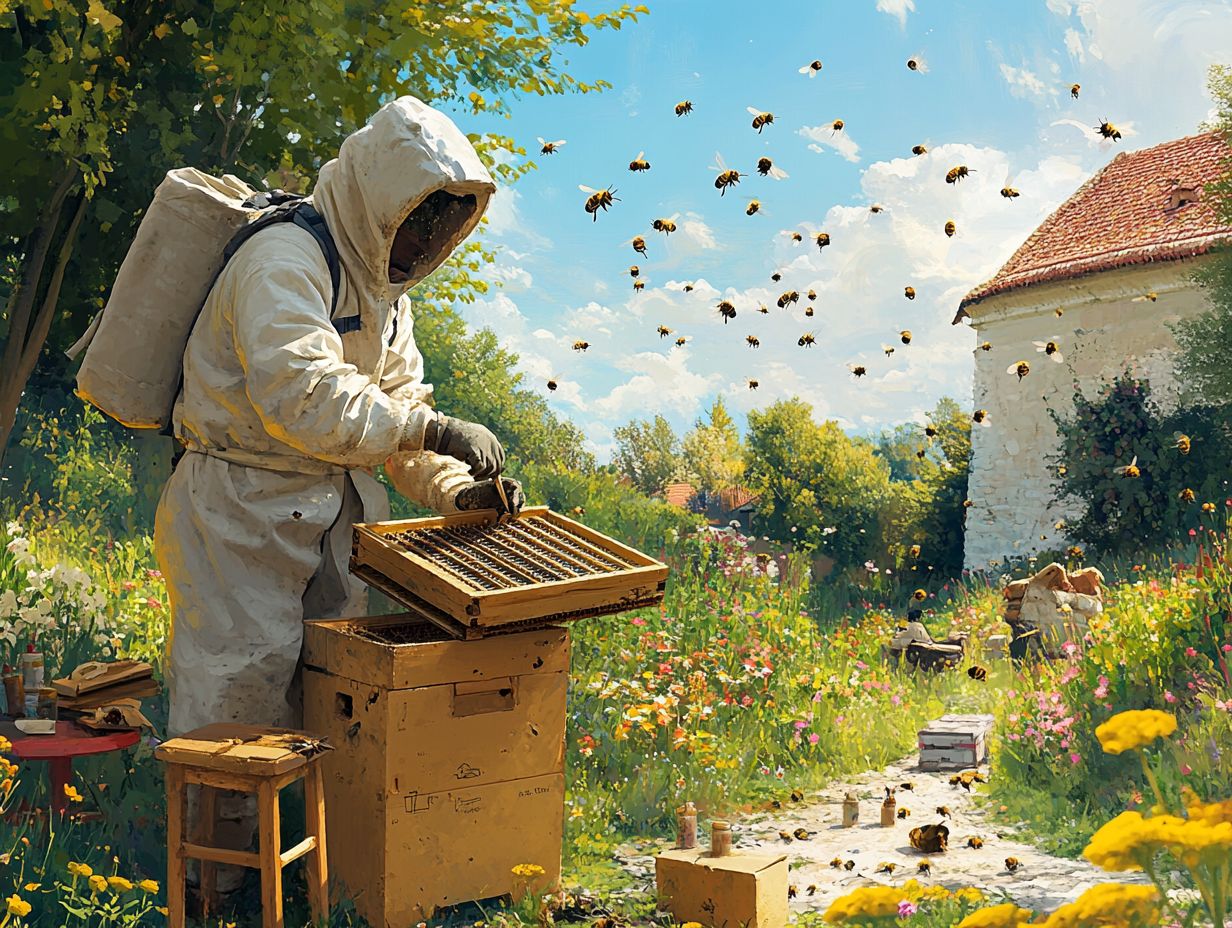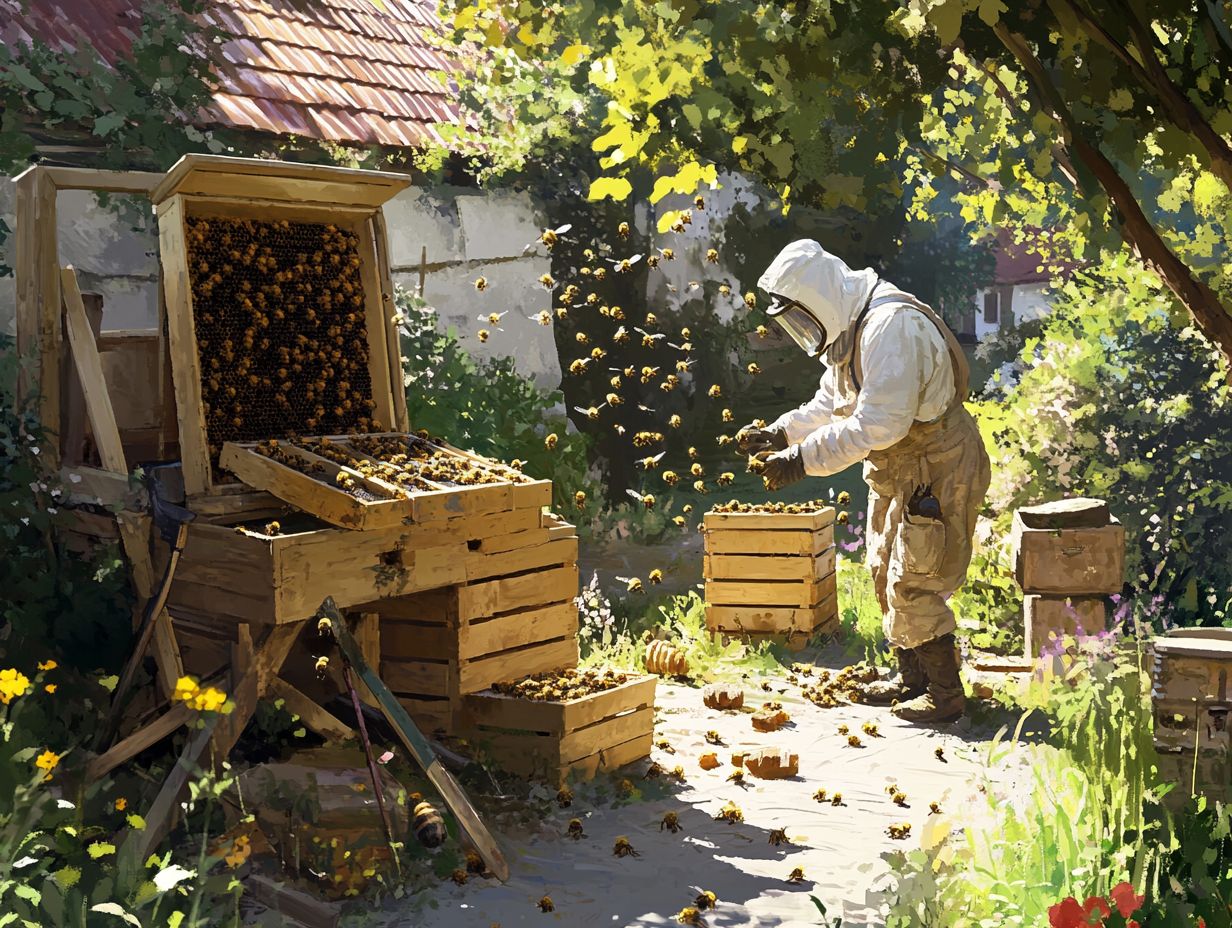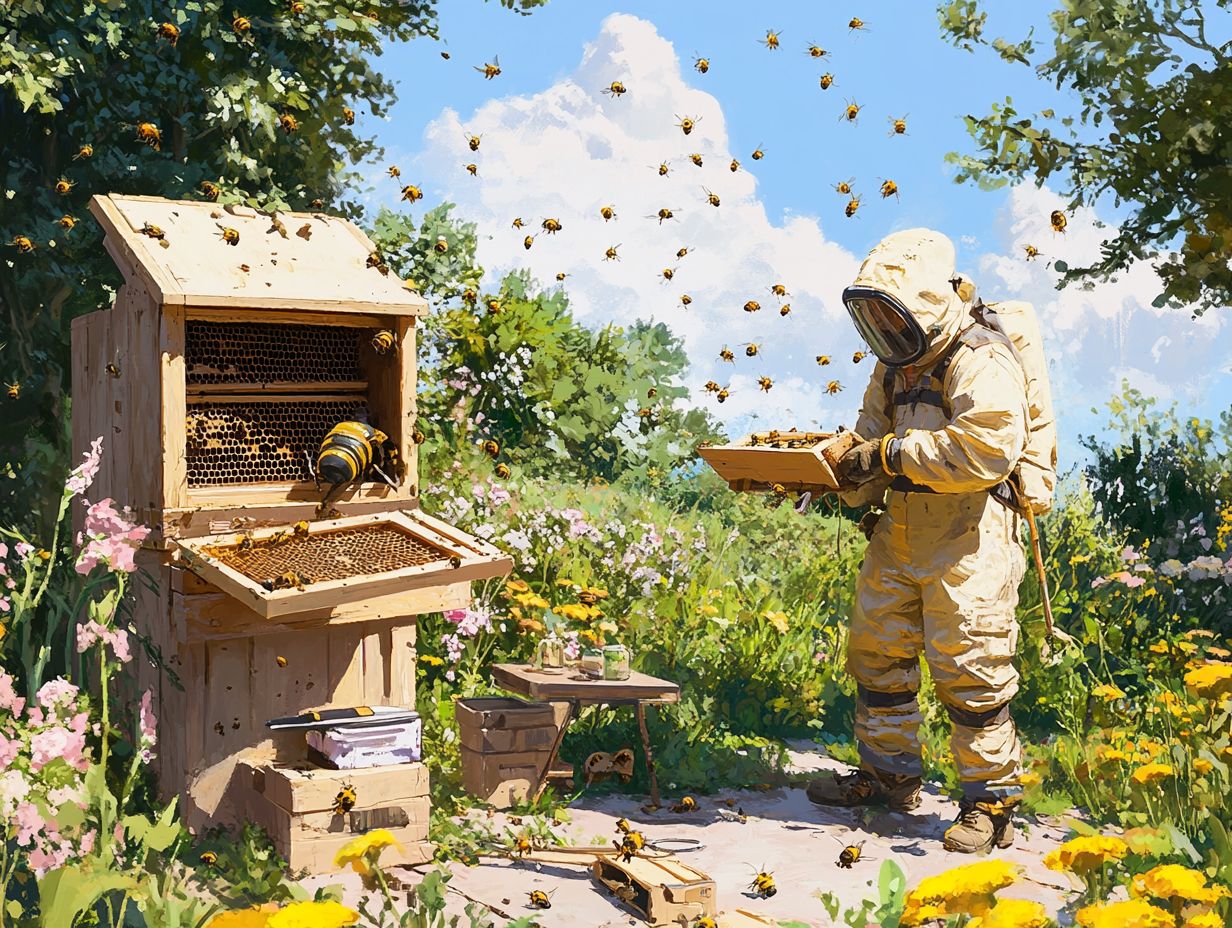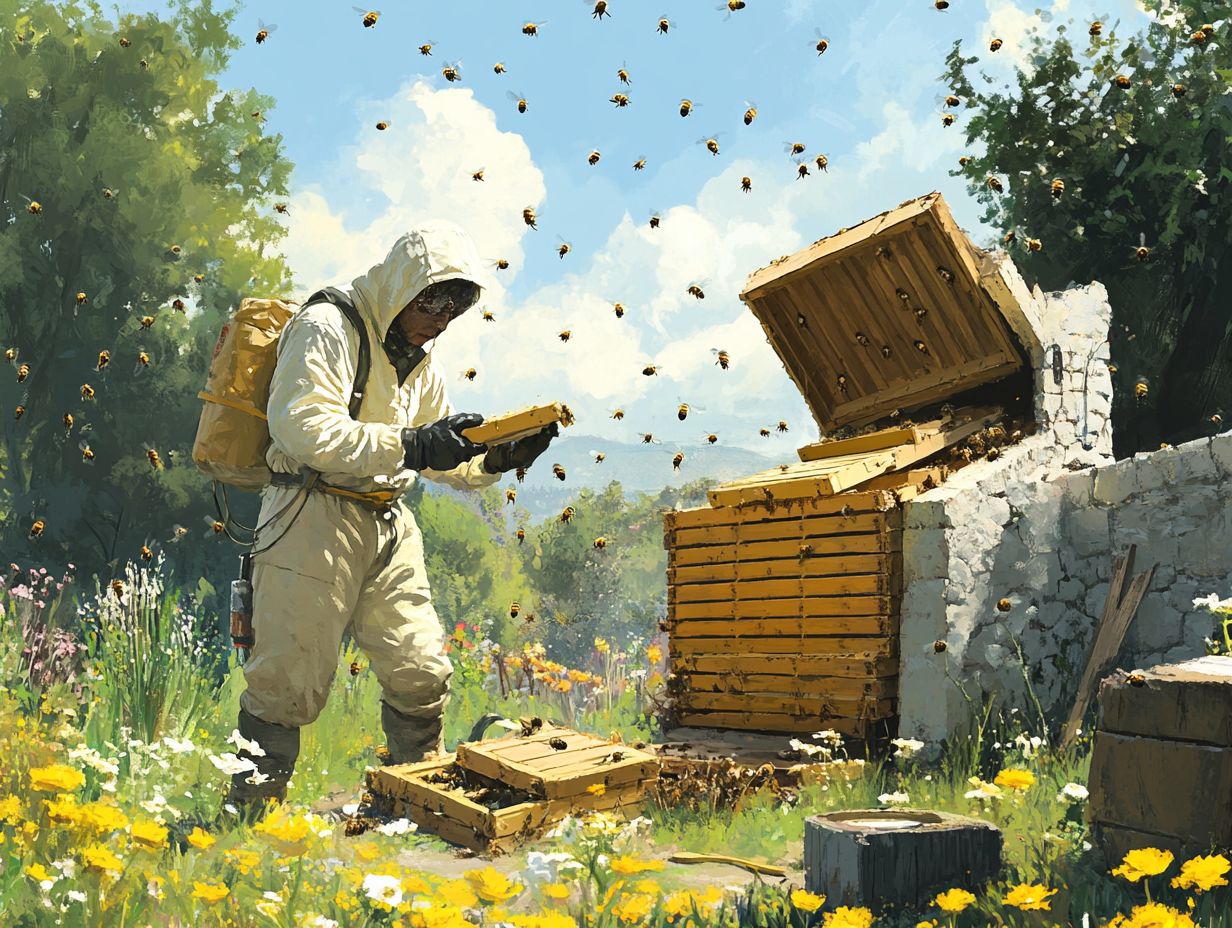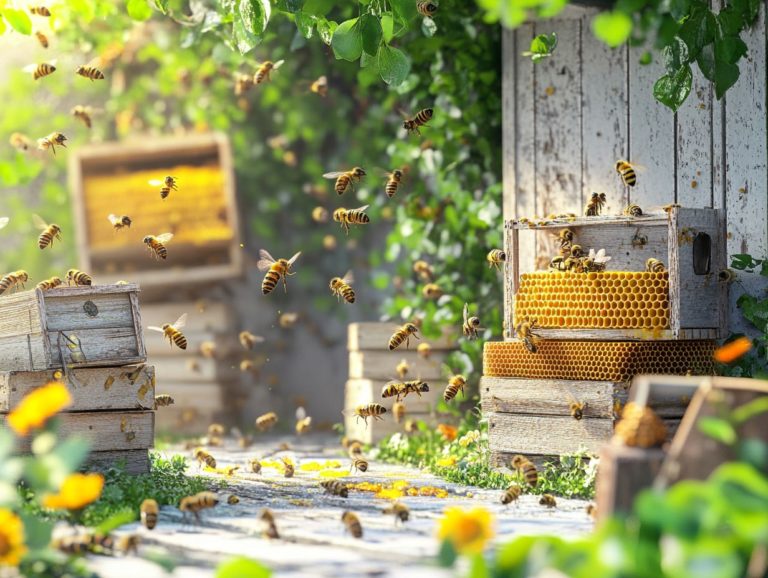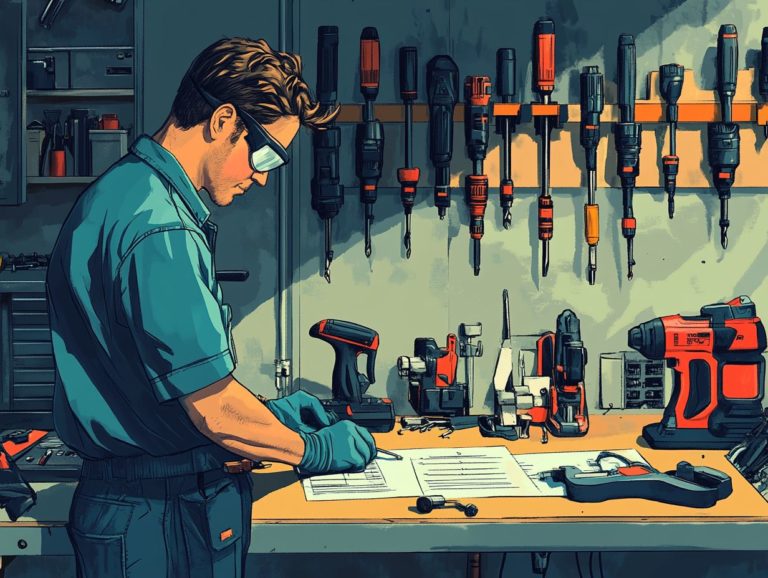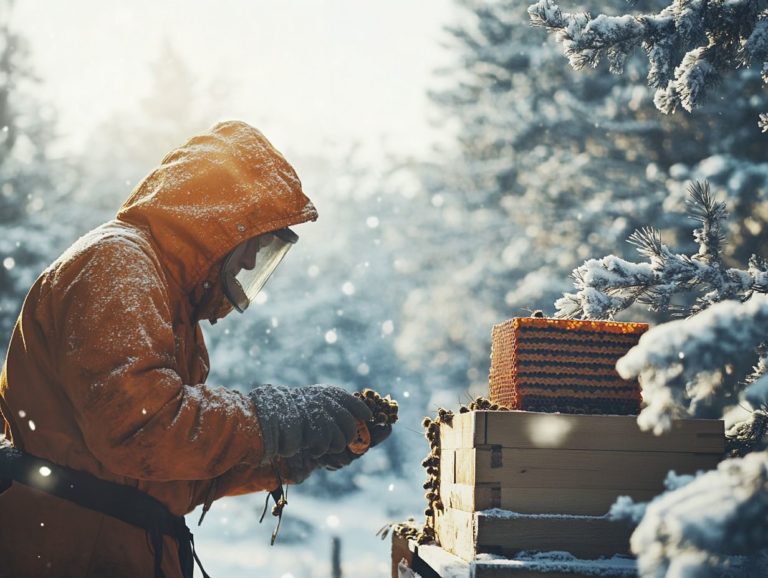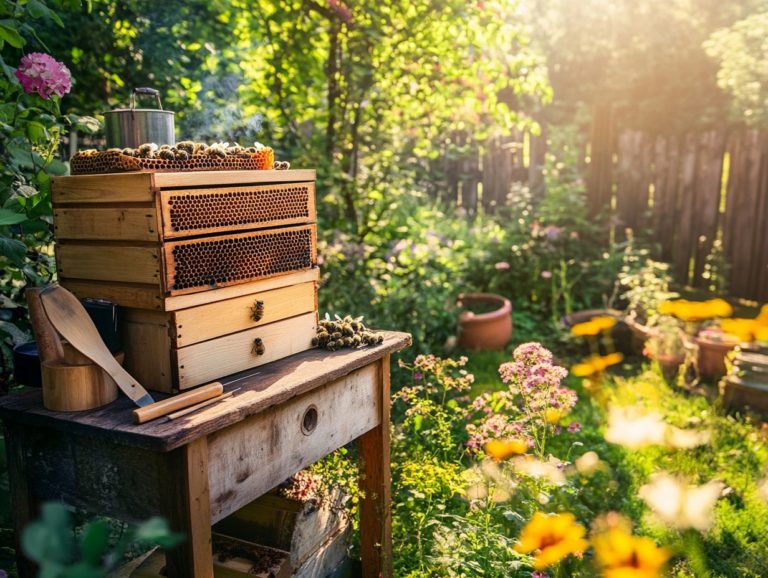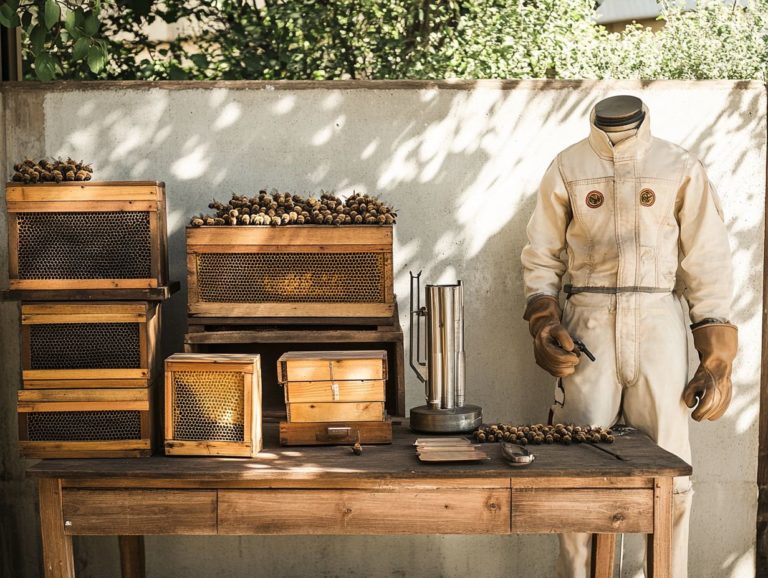5 Common Mistakes in Beekeeping Equipment Use
Beekeeping is an immensely rewarding pursuit, yet using the right equipment properly is essential for your safety and the well-being of your bees.
Many new beekeepers stumble into common pitfalls that can lead to accidents or inefficiencies. This article explores five prevalent mistakes related to beekeeping equipment, examines their repercussions, and offers valuable guidance on how to avoid them through proper record keeping.
By grasping these crucial insights, including the importance of hive placement and monitoring colonies, you will be well-prepared to nurture a thriving hive and fully embrace this captivating hobby.
Contents
- Key Takeaways:
- 1. Improper Use of Protective Gear
- 2. Neglecting Equipment Cleaning Can Harm Your Bees
- 3. Checking for Damage or Wear and Tear
- 4. Using the Wrong Tools for the Job
- 5. Not Following Proper Techniques
- Why Is Proper Beekeeping Equipment Use Important?
- Frequently Asked Questions
- What are the common mistakes in beekeeping equipment use?
- How do I maintain cleanliness in my beekeeping equipment?
- What equipment should I avoid using for beekeeping?
- What are some proper techniques for using beekeeping equipment?
- Why is it important to regularly replace old or damaged equipment?
- How should I store my beekeeping equipment?
Key Takeaways:
- Proper use of protective gear is crucial to avoid stings and injuries.
- Regularly clean equipment to prevent disease and maintain hive health.
- Inspect equipment for damage and wear to avoid accidents and ensure efficient beekeeping.
1. Improper Use of Protective Gear
Wearing protective gear improperly poses significant risks—not just for newcomers but also for the health of the entire bee population. It is essential to focus on this aspect as you embark on this rewarding hobby.
Ensuring you use the right protective gear correctly minimizes risks during hive inspections and managing bee behavior, especially in emergencies.
The essential protective gear includes:
- Veils: Vital for keeping bees away from your face; an unexpected sting there could lead to serious panic.
- Gloves: Protect your hands from stings and sharp edges of hive frames.
- Full suits: Provide a comprehensive barrier against potential attacks, particularly from aggressive bee species.
Experienced beekeepers often share cautionary tales about the consequences of neglecting proper gear. One beekeeper recalled a harrowing incident where inadequate gloves resulted in multiple stings, leading to a hasty retreat from the hive. These anecdotes underscore the importance of investing in high-quality equipment for personal safety and to cultivate a calm environment that promotes healthy bee management.
2. Neglecting Equipment Cleaning Can Harm Your Bees
Cleaning your beekeeping equipment is vital for maintaining the health of your bees and preventing diseases, including harmful parasites that can wreak havoc on colonies if left unchecked, especially during the nectar flow.
Effective cleaning practices protect your bees and foster a thriving, productive hive. Prioritize sterilizing hive boxes and tools after each use to eliminate remnants of previous treatments or pathogens. Neglecting these cleaning protocols can lead to serious emergencies, such as disease outbreaks that jeopardize your entire bee population.
This negligence can negatively impact honey production and create a ripple effect on local ecosystems and agriculture. Therefore, adopting a diligent cleaning routine is crucial for ensuring long-term sustainability in your beekeeping efforts.
3. Checking for Damage or Wear and Tear
Regularly inspecting your beekeeping equipment for damage or wear is essential for the longevity of your hives and the efficiency of your beekeeping practice.
Neglecting this task could lead to setbacks like diminished honey production and an increased risk of predators that threaten bees. Stay alert to catch any signs of damage early, especially in hive boxes, as compromised structures can expose your colonies to various threats.
Ensuring your smoker functions properly is also key, as it plays a vital role in calming your bees and facilitating safe hive inspections. Small cracks or loose joints in the hive can negatively affect overall health, making consistent equipment checks a critical practice for any committed apiarist.
Start implementing these tips today to ensure a thriving hive!
4. Using the Wrong Tools for the Job
Using the wrong tools for specific beekeeping tasks can lead to a chaotic hive management experience and may jeopardize the well-being of your bees, especially as you navigate the complexities of beekeeping as a beginner.
Choosing the right tools is essential for success. Essential items like hive tools help maintain and manage your colonies effectively during inspections. Bee smokers calm busy bees, making handling much safer. Additionally, the right feeders provide nourishment and support hive growth, particularly in early spring or during lean periods.
When assembling your starter kit, focus on quality items. Consider investing in a comprehensive beekeeping kit that covers all foundational tools. It’s also wise to consult local beekeeping mentors who can share invaluable insights on which tools work best in your area.
5. Not Following Proper Techniques
Proper beekeeping techniques are vital for maximizing honey production while ensuring the health and safety of your colonies and understanding the queen status during inspections.
This involves routine monitoring of your colonies to assess their health and productivity. Additionally, strategically placing your hives allows bees easy access to plentiful foraging areas. Effective feeding schedules, especially during times when natural food sources are scarce, can significantly boost colony growth.
If you neglect these fundamental practices, you risk poor comb building, inadequate population growth, and increased chances of swarming, which could ultimately diminish honey yields and jeopardize the hive’s viability. By prioritizing these aspects, you can cultivate a thriving environment for your colonies.
Why Is Proper Beekeeping Equipment Use Important?
The proper use of beekeeping equipment is essential for maintaining the health of your bees, ensuring efficient hive inspections, and enhancing honey production. This equipment is crucial for your success!
It not only bolsters your safety as a beekeeper but also cultivates a harmonious environment for your bee colonies. A well-structured hive acts as a protective fortress against environmental stressors and pests, creating a sanctuary for your bees, vital for their productivity and longevity.
Joining local beekeeping associations provides valuable resources covering best practices and essential training. These organizations frequently offer workshops, publications, and expert guidance, ensuring you, whether a novice or an experienced beekeeper, stay informed about the latest techniques and tools for promoting both colony health and your safety within the bee yard.
What Are the Consequences of Improper Equipment Use?
Improper use of equipment in beekeeping can lead to serious setbacks, such as increased vulnerability to pests like varroa mites, diminished productivity, and hazardous situations for both bees and beekeepers, as well as complications related to harvesting honey.
Using the wrong tools can upset the hive’s balance, causing unnecessary stress among bee colonies. Research reveals that nearly 30% of hives may experience catastrophic failures due to improper gear, leading to significant losses in honey yield.
According to a study by the American Beekeeping Federation, beekeepers using subpar equipment reported up to a 50% decrease in honey production, directly impacting their livelihoods. Moreover, erratic handling can trigger aggressive behavior in bees, increasing the risk of stings and creating a perilous atmosphere for everyone involved.
Proper equipment is not just a luxury; it’s essential for maintaining colony health and ensuring sustainable honey production.
Ready to get started? Ensure you have the right tools to create a thriving hive!
How Can One Educate Themselves on Proper Equipment Use?
Educating yourself on the proper use of beekeeping equipment is essential for any new beekeeper. You’ll find a wealth of resources at your fingertips, from online courses to local beekeeping associations and community workshops.
Diving into hands-on experiences through internships or volunteer opportunities will boost your practical knowledge. The beekeeping community is rich with valuable mentorship programs where experienced apiarists share their insights and guide newcomers through the nuanced art of hive management.
Engaging in discussions on online forums and exploring specialized beekeeping journals can also offer fresh perspectives and keep you updated on the latest practices. These avenues enhance your confidence and cultivate a sense of belonging within a supportive network, highlighting the importance of community in your beekeeping journey.
What Are the Essential Tools for Beekeeping?
The essential tools for beekeeping, including protective gear and beekeeping kits, are important for successfully managing your hives. Key items include:
- bee smoker
- hive tool
- protective gear
- well-rounded beekeeping kits specially designed for beginners.
These tools streamline your routine hive inspections and enable you to handle bees safely and efficiently. For example, the bee smoker calms the bees, making the inspection process smoother. The hive tool is critical for opening and maintaining the hive structure.
Wearing appropriate protective gear shields you from stings and allows for a more comfortable beekeeping experience. Investing in high-quality equipment is particularly beneficial for newcomers, as it can significantly bolster your skills and confidence in hive management, ultimately leading to a more rewarding honey harvesting season.
What Are Some Common Safety Tips for Beekeeping Equipment Use?
Implementing common safety tips when using beekeeping equipment is essential for ensuring a safe experience for you and the bees, ultimately nurturing a healthy bee yard.
A key piece of advice is to always wear protective gear, like gloves and a veil, to minimize the risk of stings, especially when dealing with aggressive hives.
Handling your equipment with care is equally vital; mishandling can lead to personal injury and disrupt the bees, creating unnecessary chaos. Proper hive placement—away from high-traffic areas and in a spot that allows for good ventilation—can significantly enhance safety.
An experienced beekeeper once shared how relocating their hives to a quieter area brought a sense of calm to both their bees and themselves. This highlights the importance of thoughtful practices that promote not just your safety but also the well-being of the bees.
How Can One Maintain Their Beekeeping Equipment for Optimal Use?
Maintaining your beekeeping equipment for optimal use requires regular inspections, effective cleaning techniques, and diligent record-keeping to ensure both longevity and functionality.
By routinely checking for signs of wear and tear, you can pinpoint potential issues before they escalate, ensuring your hives remain secure and healthy. Consistently cleaning your equipment eliminates harmful residues that could jeopardize the well-being of your bees or contaminate your honey, ultimately supporting higher-quality yields.
Keeping a beekeeping journal helps you track the status of your equipment and serves as a valuable tool for reflecting on past seasons. This proactive approach significantly enhances honey production and promotes overall bee health, paving the way for a thriving and sustainable apiary operation.
Frequently Asked Questions
In conclusion, understanding the importance of safety, maintenance, and training in beekeeping is vital for both your success and the well-being of your bees.
What are the common mistakes in beekeeping equipment use?
Here are five common mistakes in beekeeping equipment use: not maintaining cleanliness, using incorrect tools, neglecting proper techniques, relying on old or damaged gear, and failing to store equipment correctly.
How do I maintain cleanliness in my beekeeping equipment?
Always clean and thoroughly clean your equipment before and after each use. This simple step helps prevent disease and keeps your bees happy and healthy!
What equipment should I avoid using for beekeeping?
Avoid using equipment made of materials that may harm bees, like plastic or treated wood. Stick to using tools made from natural materials like wood and metal.
What are some proper techniques for using beekeeping equipment?
Use a smoker to calm the bees before working with them. Wear protective gear and handle frames and hives gently and carefully.
Why is it important to regularly replace old or damaged equipment?
Old or damaged equipment can harbor pests and diseases, which can harm your bees. Regularly replacing equipment ensures the health and safety of your bee colony.
How should I store my beekeeping equipment?
Store your beekeeping equipment in a dry, clean, and well-ventilated area. Protect your gear from pests and moisture to keep it in top shape!

